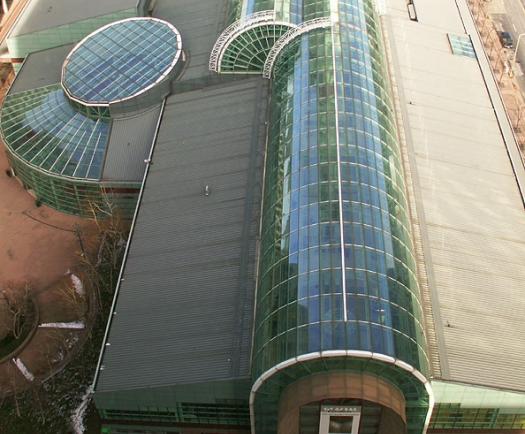Saturday, March 27, 2010
Gardens Planted Under the Glass Atrium of Cleveland Mall
The Galleria in Cleveland, Ohio, sun glinting on its barrel-shaped glass roof, now harvests sunlight for more than clothes shopping. Vicky Poole, the Galleria's marketing and events director, looked up one day and thought: This place looks like a giant greenhouse. She's now looking forward to fresh tomatoes for sale among the shops and galleries at the downtown Cleveland mall. It might be the first such garden in the US. http://www.solaripedia.com/13/211/cleveland_mall_interior_becomes_gardens.html
Labels:
atrium,
cleveland,
gardens under glass,
greenhouse,
mall,
ohio,
shopping center,
shopping mall
Saturday, March 20, 2010
Community Center Blends with Desert Environs
The entire building shell of the Henderson Community Center in Palm Desert, California, including the interior walls, is built from highly insulated panels and covered with high strength concrete. All wall surfaces and a majority of the ceiling surfaces are kept as natural concrete finish which required no paint and no drywall. All floor surfaces are polished concrete, which required no additional finish material to cover the structural concrete. The design provides for a large array of photovoltaic panels on the roof. http://www.solaripedia.com/13/209/henderson_community_center_in_california.html
Monday, March 15, 2010
Ancient Wind Towers Passively Cool Buildings
Wind towers catch cooler breezes that prevail at a higher level above the ground and direct it into the interior of buildings. Typically, a wind tower is capped and has openings on its sides toward four directions. It will either act as a solar chimney to draw hot air out of the building, or will allow cooler breezes to come down the chimney to cool the spaces below. These ancient structures were originally developed in the Mid-East, constructed mostly of thick adobe or ceramic walls with extremely high insulative values. Also known as windcatchers, wind towers can be located over an underground reservoir of water known as a qanat. Completely shaded from the sun, a qanat aggregates the cold, sinking air of the night, which is then trapped within, unable to rise up to the less dense surface air. The wind tower creates a pressure gradient which sucks at least a small amount of air upwards through the building. This cool, dry night air, being pulled over a long passage of water, evaporates some of it and is further cooled. Some modern buildings are now using wind towers as a strategy to save energy by cooling buildings using this ancient, passive principle of air flow. http://www.solaripedia.com/13/205/wind_towers_catch_the_breezes_%28mid_east%29.html
Saturday, March 13, 2010
Osa Rainforest Hosts the Lapa Rios Ecolodge
Lapa Rios is an eco-resort with a light footprint in Costa Rica. It is vigilant in energy conservation through passive design and renewable sources, and uses a sustainable approach to chemical use, waste, sewage, recycling and water management while respecting wildlife and the natural setting. In fact, no live trees were cut for the construction of the buildings. The pigs on-site are the source for cooking fuel - yes, pig poop is collected from whihc methane gas is extracted for cooking. The owners conserve a 1000-acre nature preserve and offer educational programs and tours on sustainability. They also founded a local school as part of their commitment to the community. http://www.solaripedia.com/13/203/2047/lapa_rios_aerial.html
Monday, March 8, 2010
Solar-Powered Yacht Cruises the Seas on Less Diesel
Thanks to its innovative hull design, the WHY solar-powered yacht requires less power at cruising speed than a boat of equal size. Its diesel-electric propulsion is the most efficient motorization today, and the surface of the photovoltaic panels - almost 900 square meters - covers most of the boat’s auxiliary system needs.
Its PV power is estimated to save up to 200 tons of diesel per year. http://www.solaripedia.com/13/200/roof_goes_electric_on_solar_why_yacht.html
Labels:
concentrating solar power,
house boat,
photovoltaic boat,
PV,
solar boat,
yacht
Subscribe to:
Posts (Atom)







